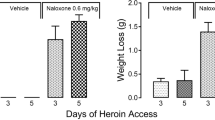Abstract
AFTER a period of abstinence, narcotic addicts, if untreated with opioids, frequently relapse and resume self-administration of opioid compounds1. Little is known about factors that influence relapse; it has been attributed to the addict's social environment and to his or her psychological need for the drug. An alternative possibility is that, because of previous exposure to opioids, post-addicts are biochemically more susceptible to the properties of opioids that produce physical dependence. Opioid compounds have long-term effects on the brain. Bound morphine persists in the rat brain for at least three weeks after a single dose2. Tolerance to morphine was observed 1 year after a single dose of morphine to rats3 and evidence has been presented for an immunological theory of morphine tolerance4. In man5 and rats6 homeostatic disturbances resembling abstinence signs can be detected six months after the acute phase of withdrawal. By contrast with the reported chronic and persistent effects of morphine, Cheney and Goldstein7 have recently shown that the median effective dose of naloxone for precipitating withdrawal-jumping in morphine-dependent mice was unchanged by earlier dependence on morphine. As the evidence for long-term effects of morphine was obtained principally in rats, we have further studied morphine dependence in this animal to determine if previous exposure to morphine permanently alters the neural substrates for producing physical dependence on morphine.
Similar content being viewed by others
References
Hunt, G. H., and Odoroff, M. E., Public Health Reports, 77, 41 (1962).
Misra, A. L., Mitchell, C. L., and Woods, L. A., Nature, 232, 48 (1971).
Cochin, J., and Kornetsky, C., J. Pharmacol. Exp. Ther., 145, 1 (1964).
Cochin, J., and Kornetsky, C., Res. Pub. Assoc. Nerv. Ment. Disord., 46, 268 (1967).
Himmelsbach, C. K., J. Pharmacol. Exp. Ther., 73, 91 (1941).
Martin, W. R., Wikler, A., Eades, C. G., and Pescor, F. T., Psychopharmacologia, 4, 247 (1963).
Cheney, D. L., and Goldstein, A., Nature, 232, 477 (1971).
Gibson, R. D., and Tingstad, J. E., J. Pharmaceut. Sci., 59, 426 (1970).
Way, E. L., Loh, H. H., and Shen, F. H., J. Pharmacol. Exp. Ther., 167, 1 (1969).
Martin, W. R., Pharmacol. Rev., 19, 464 (1967).
Goode, P. G., Brit. J. Pharmacol., 41, 558 (1971).
Siegel, S., Nonparametric Statistics for the Behavioural Sciences, 116 (McGraw-Hill, Toronto, 1956).
Wikler, A., Pescor, F. T., Miller, D., and Norell, H., Psychopharmacologia, 20, 103 (1971).
Wei, E., Loh, H. H. and Way, E. L., J. Pharmacol. Exp. Ther. (in the press).
Author information
Authors and Affiliations
Rights and permissions
About this article
Cite this article
WEI, E., LOH, H. Biological Sciences: Morphine Physical Dependence unaltered by Previous Dependence on Morphine. Nature 238, 396–397 (1972). https://doi.org/10.1038/238396a0
Received:
Revised:
Issue Date:
DOI: https://doi.org/10.1038/238396a0
- Springer Nature Limited
This article is cited by
-
Acute opioid dependence: characterizing the early adaptations underlying drug withdrawal
Psychopharmacology (2005)
-
Opioid physical dependence development: effects of single versus repeated morphine pretreatments and of subjects' opioid exposure history
Psychopharmacology (1994)
-
Reversibility of morphine tolerance and dependence in guinea pig brain and myenteric plexus
Nature (1974)
-
Assessment of precipitated abstinence in morphine- dependent rats
Psychopharmacologia (1973)





